The Vietnam’ floating markets are open-air markets held entirely on water. Boats become stalls, and business is done by paddle, pole or engine. At a proper floating market, most of the buyers and sellers are locals. Farmers arrive early with fresh harvests. Food vendors cook breakfast right on their boats. Buyers navigate between them, haggling, chatting and picking up everything from produce to petrol.
In Southern Vietnam, Mekong Delta is a vast land rich in culture, tradition and life of its people shaped by water. For generations, floating markets have been the heartbeat of trade in the Delta. Along the countless rivers and canals winding through islets, vibrant gatherings happen boat to boat. Sellers offer everything from fresh fruits to hot noodle soup, from rice to household items, while buyers paddle through the market at sunrise. It’s a chaotic, colourful scene that gives a rare and authentic insight into local life and the long-standing river-based trade. While these markets have evolved over time, many still operate in much the same way they always have. In this guide, you’ll get a closer look at two of the most well-known floating markets in Vietnam, how to visit them the right way, and what to expect from this truly one-of-a-kind experience.
1. A brief history of floating markets in the Mekong Delta, Vietnam
The floating markets in the Mekong Delta have been around for over a hundred years, born out of geography and necessity.
Before the region had good roads or railways, rivers were the lifelines of southern Vietnam. The Mekong Delta is crisscrossed with thousands of waterways, and boats were the most efficient way to transport goods. Farmers from rural areas used the rivers to bring their produce - especially rice, fruits, and vegetables - to larger towns. And buyers? They met them on the water.
Instead of bringing goods to land-based markets, the markets came to life right on the water. Boats would gather at dawn in bustling clusters, engines chugging, vendors shouting prices, and buyers rowing up to inspect the goods. It was an early form of mobile retail and distribution, suited perfectly to the region's infrastructure.
These markets weren't designed for tourists. They were and in some cases still are functional trading hubs for locals.
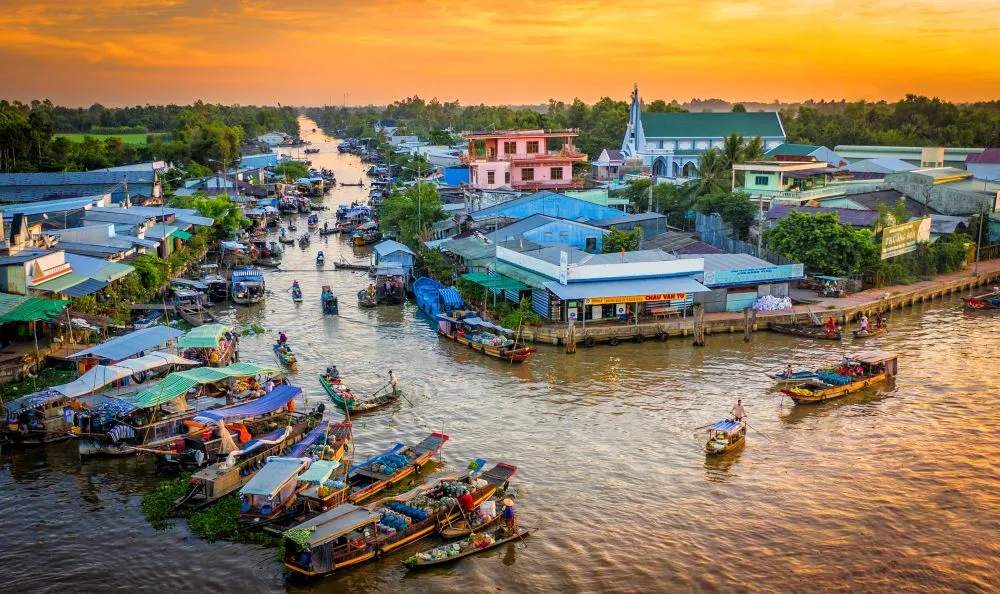
Cai Rang Floating Market in Can Tho at sunrise, Mekong Delta, Vietnam
Over time, as road networks developed and supermarkets arrived, many Mekong floating markets either shrunk or disappeared. But a few still remain, like Cai Rang and Long Xuyen, where the atmosphere of Vietnam's riverine past is still very much alive.
2. Cai Rang floating market
If you’ve heard of any floating market in Vietnam, it’s probably Cai Rang floating market - and for good reason. Located just a few kilometres from Can Tho, the Delta’s largest city, Cai Rang is the biggest and busiest floating market in the region.
This floating market in Can Tho comes to life early. By 6:00 AM, dozens of boats are already packed along the river, piled high with tropical fruits like pineapples, melons, grapefruits and vegetables like sweet potatoes, cassava and more. Others are mobile kitchens, serving steaming bowls of hu tieu (rice noodle soup), bun mam (fermented fish noodle soup), banh mi or pouring strong Vietnamese coffee into the cups.
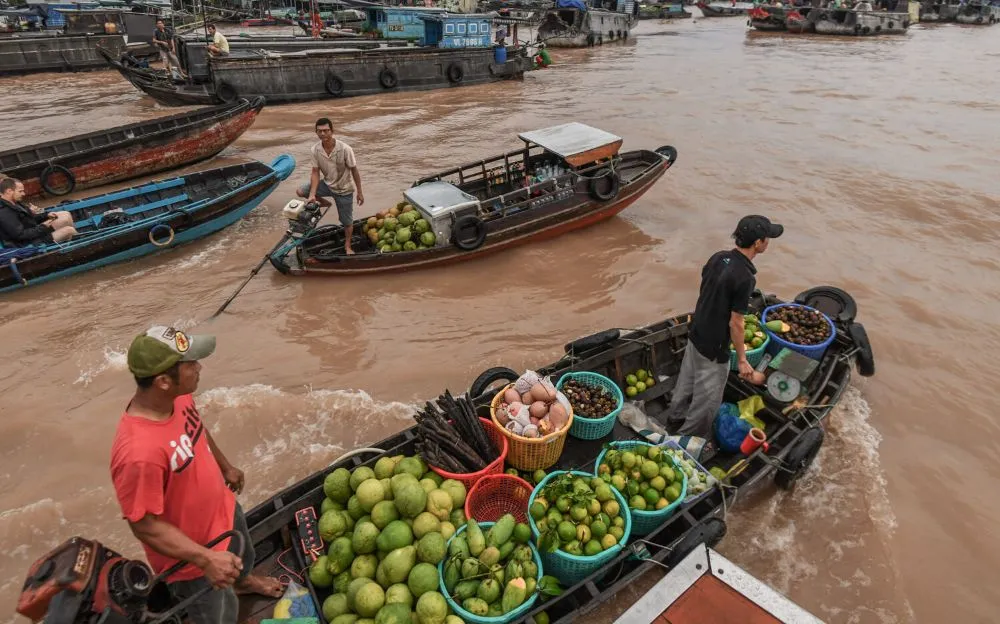
Boats filled with grapefruits, mangos and star apple fruits at the bustling Cai Rang floating market
The atmosphere in Cai Rang floating market is busy, however welcoming. You’ll see wholesale buyers making big transactions, and smaller boats selling snacks, drinks, or household items. Most sellers hoist their goods on a long bamboo pole, called “cây bẹo”, so from a distance, you can see what each boat is selling without shouting.
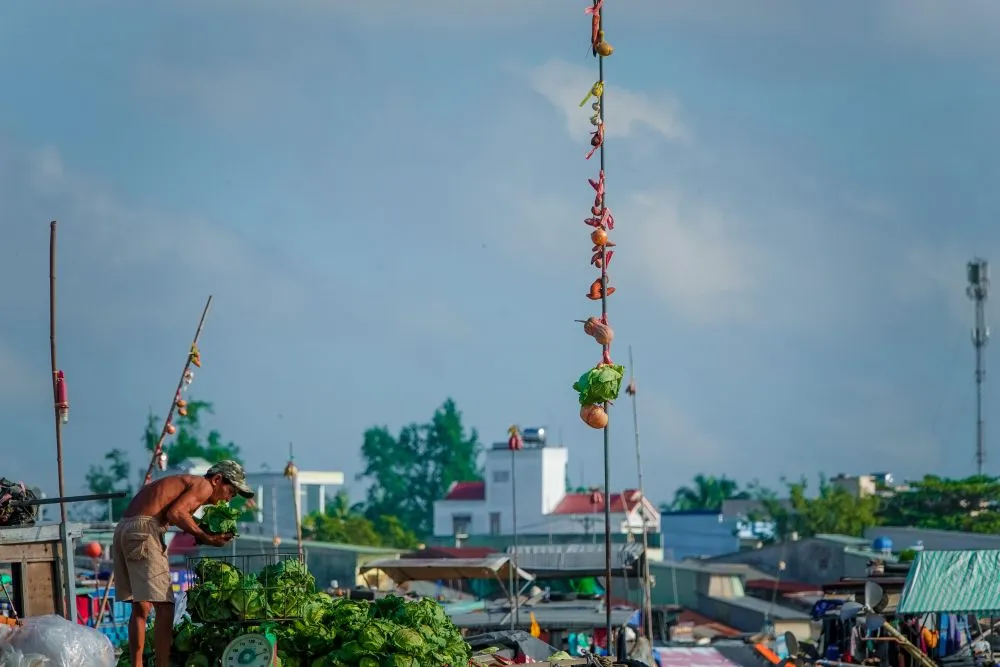
Cây bẹo used to display goods at a floating market in Vietnam
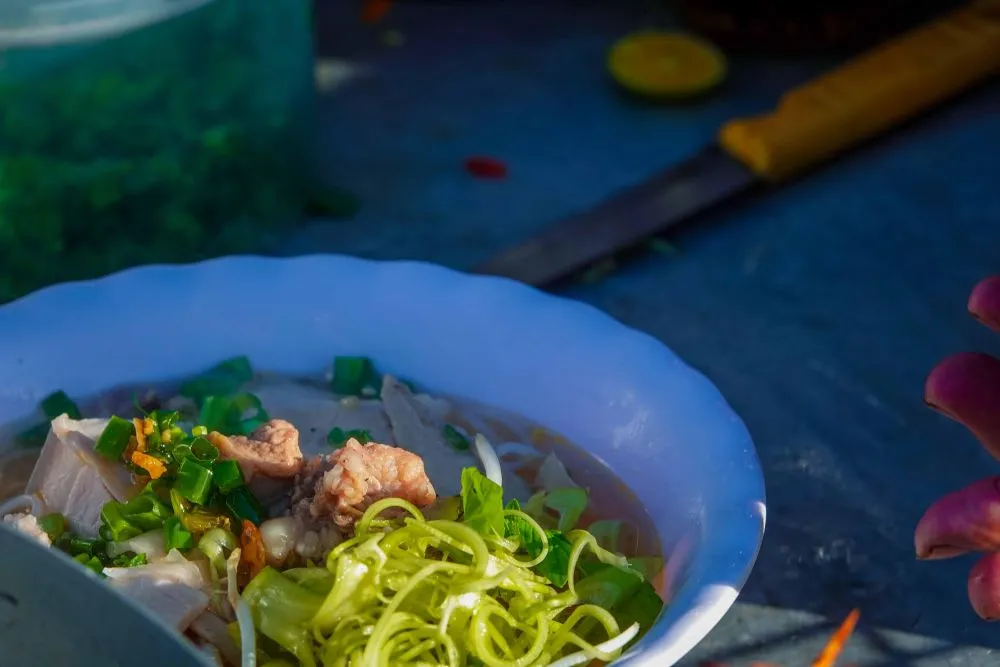
A bowl of delicious Rieu rice noodles
How to visit the Cai Rang floating market?
From Can Tho city centre, it’s a short taxi ride to the Ninh Kieu Wharf. From there, you can hop on a small boat tour, usually lasting 2–3 hours. Tours often include a stop at a local noodle factory or fruit orchard.
Another option is to take a taxi from Can Tho city centre to An Binh Market, which is located near the floating market, and rent a boat from there. This can be a more time- and cost-efficient choice. Prices typically range from 17 to 46 US$, depending on the boat type, group size and chosen route.
Aim to be on the water by 5:30 - 6:00 AM as the market starts to wind down by 8:00.
>> See more: 18 Best things to do in Can Tho
3. Long Xuyen floating market
If Cai Rang is the most famous floating market in the Mekong Delta, Long Xuyen Floating Market is its quieter, more authentic cousin. Located in An Giang Province, about 2 hours from Can Tho, Long Xuyen offers a more relaxed, less commercialised experience. In fact, this is still the second largest in the region. That’s exactly what makes it special.
Long Xuyen floating market isn’t designed for tourists, it’s a working market for traders from Long Xuyen city and surrounding areas. You won’t find souvenir boats or staged photo ops here. Instead, expect to see real trading happening between farmers, vendors and wholesalers.
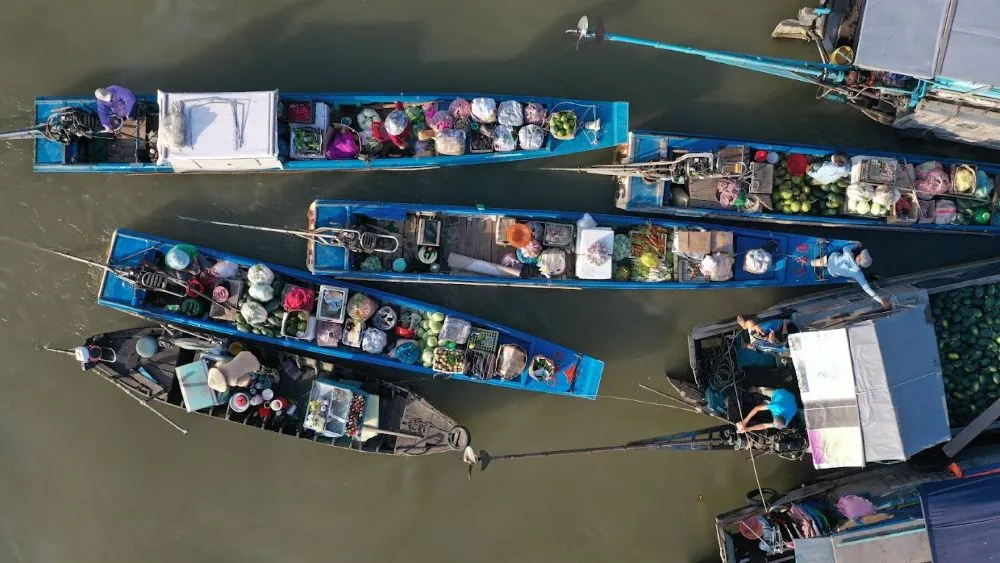
Top view of narrow boats docked close together, selling various fresh produce at Long Xuyen floating market
The market stretches gently along the Hau River, with boats selling fresh vegetables, fruits, fish and local staples. You’ll also spot a few food vendors, often cooking from tiny stoves on their boats, serving breakfast to nearby traders. Vendors move from one boat to another in search of goods, displaying what they have for sale on poles. Everything feels more low-key and genuine.
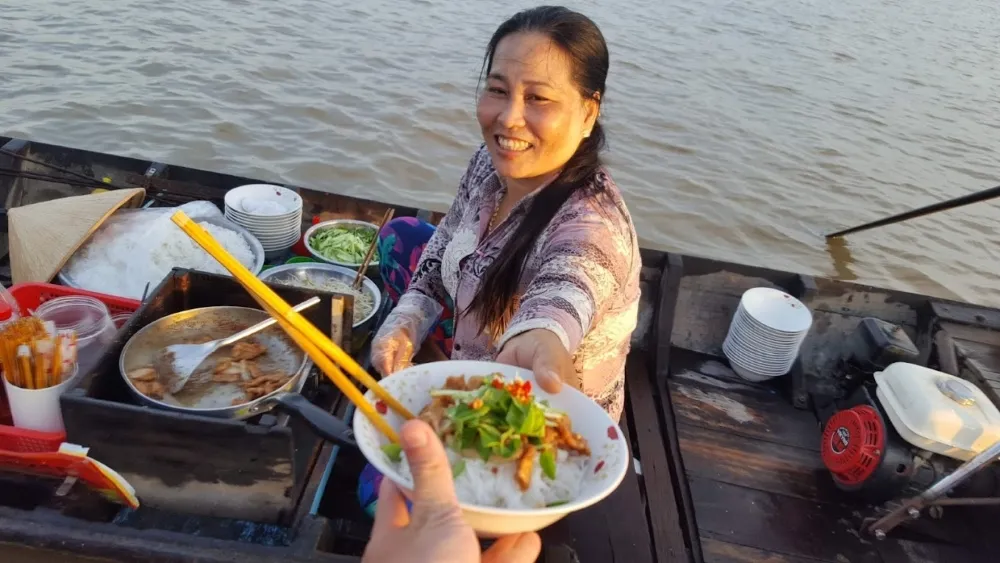
Traditional Vietnamese breakfast served on a boat at a floating market in the Mekong Delta
You’ll likely be the only foreigners around, which gives you a rare chance to observe the market as it really is, not as it’s been adapted for outsiders.
How to visit Long Xuyen floating market?
Long Xuyen is best reached by car or bus from Can Tho (roughly 2 hours). Once there, you can arrange a boat through your hotel or with a local guide at the dock.
If exploring this market by yourself, rent a motorized boat from Ô Môi pier to reach Long Xuyen Market. Prices typically range from 14 to 23 US$, depending on the time, boat type and group size.
Like all floating markets, start early, so you should aim for around 6:00 AM.
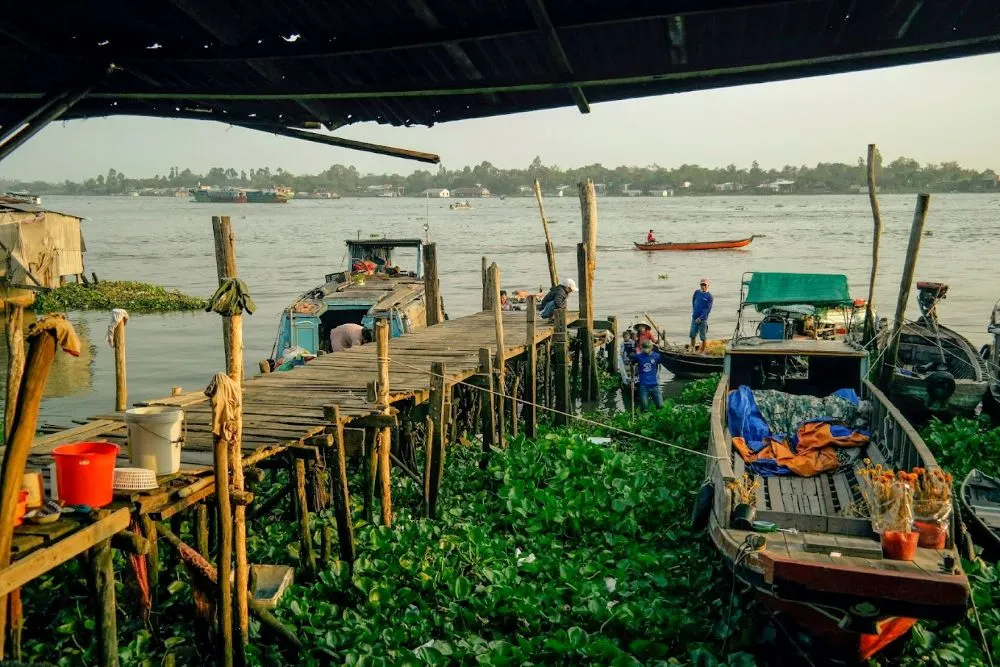
Sunrise over one of Long Xuyen floating market's boat docks
4. Other floating markets in the Mekong Delta
While floating markets were once a central part of life in the Mekong Delta, road infrastructure, online shops and supermarkets have caused several to shrink or shut down. These are 6 once lively floating markets in Mekong Delta, Vietnam (information updated in April 2025).
Ngã Năm Floating Market
Ngã Bảy (Phụng Hiệp) Floating Market
Tra On Floating Market
Ca Mau Floating Market
Cai Be Floating Market
Phong Dien Floating Market
5. Best time to visit floating markets in Vietnam

Floating markets run early - “really early”. The best time to arrive is between 5:30 and 6:00 AM. By 8:00, most of the action had slowed down, especially at Cai Rang. Long Xuyen tends to linger a bit longer, but even there, the liveliness fades with the rising sun.
To catch the full experience of busy trading, breakfast cooking, the golden light on the water, you’ll want to be on a boat just as the sky begins to brighten.
Best season to go?
Dry season (December to April) is ideal. The weather is clear, boat rides are smoother, and the markets are more active.
The rainy season (May to November) brings fewer tourists and a more local vibe, but also the chance of sudden showers. Morning visits are usually fine even during this season.
Lunar New Year: In the days leading up to Tet (Vietnamese Lunar New Year), floating markets, especially in the Mekong Delta, become bustling hubs of activity. Boats are laden with vibrant flower pots and round watermelons, essential items for the festive season. These markets operate almost throughout the day to meet the high demand from consumers preparing for the New Year celebrations. However, during the 4 major days of Tet, these markets typically close as vendors return home to celebrate with their families, honoring the tradition of family reunions during this significant holiday.
6. Local tips
Bring small notes in case some vendors will sell you snacks or coffee directly from their boat.
Don’t just stay in a big tourist boat. If you can, choose a smaller boat to get closer to the action.
Try breakfast if you get the chance. If it’s locals eating, that’s a good sign.
For a quieter experience, avoid weekends when tourist traffic picks up.
A guide can be helpful here, especially if you want to learn more about what’s being sold and said between locals.
Floating markets in Vietnam show you how people live, trade, and connect in a landscape ruled by water. Yes, some markets have changed. But in places like Cai Rang and Long Xuyen, the tradition still flows strong. Go early. Go curious. And go with the mindset that the travel isn’t in the spectacle, it’s in the quiet, real-life rhythm of a culture that’s spent generations trading on the water.
See more:














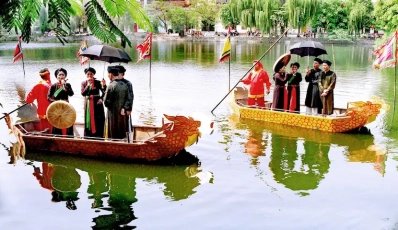
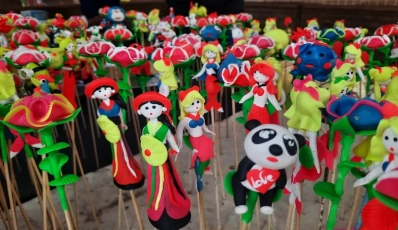

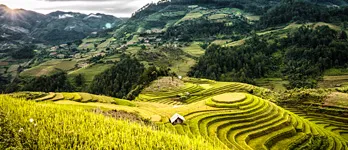
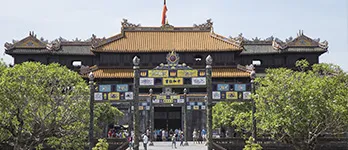


 TRAVELERS' CHOICE 2026
TRAVELERS' CHOICE 2026 



02 Comments
Vietnam
If we visit the Mekong Delta, what time should we start the tour to capture a beautiful view of the beginning of these floating markets?
Vietnam
Write Reply